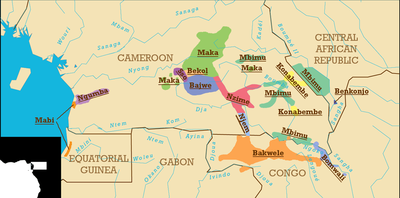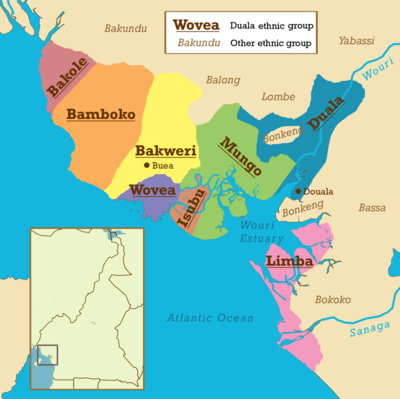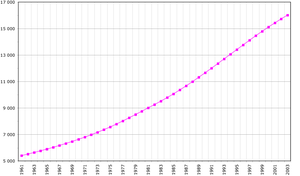Demographics of Cameroon
2007 Schools Wikipedia Selection. Related subjects: African Geography
The demographic profile of Cameroon is complex for a country of its population. Cameroon is comprised of an estimated 250 distinct ethnic groups, which may be formed into five large regional-cultural divisions:
- western highlanders ( Semi-Bantu or grassfielders), including the Bamileke, Bamum (or Bamoun), and many smaller Tikar groups in the Northwest (est. 38% of total population);
- coastal tropical forest peoples, including the Bassa, Duala (or Douala), and many smaller groups in the Southwest (12%);
- southern tropical forest peoples, including the Beti-Pahuin, Bulu (a subgroup of Beti-Pahuin), Fang (subgroup of Beti-Pahuin), Maka, Njem, and Baka pygmies (18%);
- predominantly Islamic peoples of the northern semi-arid regions (the Sahel) and central highlands, including the Fulani (or Peuhl in French) (14%); and
- the " Kirdi", non-Islamic or recently Islamic peoples of the northern desert and central highlands (18%).
An up-to-date demographic profile is unavailable from the country's government, which hasn't published census data since 1976.
Demographic data
The Cameroon government held two national censuses during the country's first 44 years as an independent country, in 1976 and again in 1987. Results from the second head count were never published. A third census, expected to take years to product results, began on November 11, 2005, with a three-week interviewing phase. It is one of a series of projects and reforms required by the International Monetary Fund as prerequisites for foreign debt relief.
Nearly all of the following demographic statistics are from the CIA World Factbook.
Population
- 17,340,702
- Note: estimates for this country explicitly take into account the effects of excess mortality due to AIDS; this can result in lower life expectancy, higher infant mortality and death rates, lower population and growth rates, and changes in the distribution of population by age and sex than would otherwise be expected (July 2006 est.)
Age structure
- 0-14 years: 41.2% (male 3,614,430/female 3,531,047)
- 15-64 years: 55.5% (male 4,835,453/female 4,796,276)
- 65 years and over: 3.2% (male 260,342/female 303,154) (2006 est.)
- 15-64 years: 55.5% (male 4,835,453/female 4,796,276)
Population growth rate
- 2.04% (2006 est.)
Birth rate
- 33.89 births/1,000 population (2006 est.)
Death rate
- 13.47 deaths/1,000 population (2006 est.)
Net migration rate
- 0 migrant(s)/1,000 population (2006 est.)
Sex ratio
- At birth: 1.03 male(s)/female
- Under 15 years: 1.02 male(s)/female
- 15-64 years: 1.01 male(s)/female
- 65 years and over: 0.86 male(s)/female
- Total population: 1.01 male(s)/female (2006 est.)
- Under 15 years: 1.02 male(s)/female
Infant mortality rate
- Total: 63.52 deaths/1,000 live births
- Male: 67.38 deaths/1,000 live births
- Female: 59.53 deaths/1,000 live births (2006 est.)
- Male: 67.38 deaths/1,000 live births
Life expectancy at birth
- Total population: 51.16 years
- Male: 50.98 years
- Female: 51.34 years (2006 est.)
- Male: 50.98 years
Total fertility rate
- 4.39 children born/woman (2006 est.)
HIV/AIDS
- Adult prevalence rate: 6.9% (2003 est.)
- People living with HIV/AIDS: 560,000 (2003 est.)
- Deaths: 49,000 (2003 est.)
- People living with HIV/AIDS: 560,000 (2003 est.)
Major infectious diseases
- Degree of risk: very high
- Food or waterborne diseases: bacterial diarrhea, hepatitis A, and typhoid fever
- Vectorborne diseases: malaria and yellow fever are high risks in some locations
- Water contact disease: schistosomiasis
- Respiratory disease: meningococcal meningitis (2005)
- Food or waterborne diseases: bacterial diarrhea, hepatitis A, and typhoid fever
Nationality
- Noun: Cameroonian(s)
- Adjective: Cameroonian
Ethnic groups
- Cameroon Highlanders 31%, Equatorial Bantu 19%, Kirdi 11%, Fulani 10%, Northwestern Bantu 8%, Eastern Nigritic 7%, other African 13%, non-African less than 1%
Religions
- Indigenous beliefs 40%, Christian 40%, Muslim 20%
Languages
There are 24 major African language groups in Cameroon; additionally, English and French are official languages. Cameroonian Pidgin English is also widely spoken.
Peoples concentrated in the Southwest and Northwest Provinces — around Buea and Bamenda — use standard English and Cameroonian Pidgin English, as well as their local languages. In the three northern provinces — Adamawa, North, and Far North — either French or Fulfulde (the language of the Fulani) is widely spoken. Elsewhere, French is the principal second language, although pidgin and some local languages such as Ewondo, the dialect of a Beti clan from the Yaoundé area, have a wide currency.
Indigenous languages of Cameroon include:
- Basaa
- Bikya
- Bung
- Kanuri
- Ngumba
- Yeni
- Bamum
Literacy
- Definition: age 15 and over can read and write
- Total population: 79%
- Male: 84.7%
- Female: 73.4% (2003 est.)
- Total population: 79%



